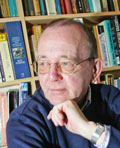A week or so ago, I got an email from an old friend and former colleague. He has forsaken mainstream academe to become a freelance lecturer, working nowadays across the world, but it so happened that this week he was speaking just a few miles away. Would I like to attend as his guest, and catch up over lunch afterwards?
- (I just googled his name, and his site came up second out of almost 9m hits. He must be doing something right, and I withdraw any silly remarks I made to him earlier about his site! It only goes to show the triumph of substance over style.
- And I recalled the first time we met, when he was doing an informal staff-development session in the college library on the use of the Overhead Projector, about thirty years ago. I learned more in half an hour about reveals, overlays, layout, colour... than I could have believed possible. The technology has moved on, and he has kept up with it, but not for its own sake.)
J. has been lecturing for 30+ years. In his present incarnation, as it were, he has a standard repertoire of about a dozen talks, so goodness knows how many times he has delivered each of them (well, I shouldn't be surprised if he also keeps track...) And yet, as we talked afterwards, it became clear that they never stand still--much of our discussion was about what to put in and what to leave out, and how to get even better. More of that later (mini-point: he was of course very good at flagging points within the talk for later comment, creating a little sense of expectation, on which he of course duly delivered).
And yet he saw an opportunity to get some honest (and, dare I say it, professional) feedback--and took it. It takes confidence to do that. (Contrast with this incident.)
The context, of course, was a little different from my usual observations:
- It is debatable whether he was teaching. The lecture was to a decorative and fine arts society; the audience were certainly interested, and they may well have picked up some fascinating information along the way, but they were not primarily there to learn. After all, the programme of events for the society was never designed as a curriculum.
- So, in terms of evaluation, using dear old Kirkpatrick, only level one [ Reaction - what participants thought and felt about the training (satisfaction; "smile sheets") ] really matters. Or does it? And how should it be construed? In other words, is this simply entertainment?
As PhD Comics fortuitously put it the other day;
(The small text reads: "Where n = the number of academics in the room who think they know how to fix it, and 1 = the person who finally calls the A/V technician")
J brings his own equipment, and had it set up well in advance. He knows it thoroughly, and its capability to fill the screen in a large hall. It was just ironic that the chairwoman of the society's opening remarks included a vote of thanks to the couple who were just stepping down from arranging the audio-visual facilities, having done it for many years.
Not only did he set it up, he also had a rolling presentation--of quotations about wine--which he set running as the audience arrived. Some knew each other so there was some lively chatter, but there were quite a few singletons, who probably appreciated something to look at while waiting. The screen went blank for the notices about forthcoming events, and the introductory remarks.
Having been introduced, he took up his position at the side of the stage, where a boom microphone had been set up. As we discussed later, he prefers a lavalier radio mic. because it does not restrict you to one spot, sometimes it is simpler to adapt to the normal provision.
He did not launch into the talk at once. As the lights were being dimmed he requested that those at the rear of the hall be left on, lest their dimming encourage people to nod off. I've no idea whether this really happens or not, but it did--more importantly in my view--send a message, "I know what I'm doing; I'm an old hand; you can relax."
He asked if everyone could hear, stepped up to the mic. and away from it, and back again. It was clear the amplification was not necessary, so that gave him a little more flexibility, although he kept it on. Later he told me that when he started doing these talks, he arranged several sessions with a voice coach to ensure he would not wear his voice out. The coach invoked John Wesley as testimony to the capacity of the unaided voice to reach thousands of people, even in the open air.
And then he told a self-deprecating and entertaining anecdote about his late mother's opinion of his ability as a public speaker, while the audience settled down to listen...and so to the lecture itself, marked by the first "slide".
- I've gone on about this at some length because it was all about that "sending a message" to the audience, and it is (I generalise wildly) largely neglected in academe. Of course, as the link above suggests, you can't not send a message, but often--as academic staff of an accredited institution--we rely on its prestige, and even its branding, to send an institutional message to students so we think we don't have to bother. After all, our audience members are not lively nudging-elderly people who could readily choose to do many other things this Tuesday morning, and who generally trust the Society to book interesting and entertaining speakers, but who also know that they occasionally get deadly bores, and who need to be re-assured on each occasion... our students are signed up to a package of which we are a part, and are largely stuck with us. So we don't have to pay attention to these messages. So we don't. And they default to "It's not worth the bother." or worse, "You're not worth the bother." No--attention to these messages is not beneath us.
(The lecture was about the Shakers of North America. The link is not very informative, but the lecture itself is!)
As befits his subject, J's presentation package was simple*, even plain, but beautifully crafted. As Thomas Merton apparently said (or--being a Trappist monk--wrote), "The peculiar grace of a Shaker chair is due to the fact that an angel might come by and sit on it." But he would probably have adopted the same style for any of his presentations.
The slides mostly had plain blue backgrounds, with white sans-serif text. Sometimes, where relevant, a monochrome picture, appropriately faded, stood in for the background--that's an effective way of tying subordinate points into a common heading. No flashy transitions or animations, just occasional highlighting. (I did suggest that some of the highlighting on a map of settlement locations was too subtle and did not really do its job--but it is when you get to that kind of nit-picking that you are aware of the underlying quality!)
We had a slightly more committed difference about the wordiness of some of the text. J argues that while the visuals complement the lecture, they should be able to be read sensibly as free-standing text. For his predominantly elderly audience, perhaps compensating between visual and aural channels**, he may well be right. I'm more inclined to minimalism; the fewer words the better, each one a keyword for an idea. Coherent prose comes way down the field. (Indeed, switch the presentation package to Prezi, for example, and that is almost forced on you...)
Nevertheless, J never turned to look at the screen behind him (after all, the content was on his laptop before him) and when he showed a quotation on screen, he did not read it out loud. But he did keep quiet to allow the audience to read it. Again, I'm sure that works well with his constituency, and indeed his aspirations (Kirkpatrick levels 1 and perhaps 2). But I wouldn't want (as J wouldn't) to recommend it context-free.
Most of the time the visuals ran in parallel with the lecture itself--I think I remember some counter-point juxtapositions, but subtly done.
J did not announce his objectives at the start of the session--as I noted with interest, because when we first met many years ago he was very keen on making objectives clear. But of course the context was different--no-one was going to ask, "Why do we have to learn this?" or, "Will this be in the exam?" Even so, he was careful to sign-post each section of the lecture. It was billed as "The Shakers: Their Beliefs, Architecture and Artefacts", and so it was made clear how we were progressing through the material. The only part which was not signposted was the final few minutes in which J talked about being in touch (by email--they never eschewed technology) with one of the last three surviving Shakers, and told of the agony of some recent events among them. That touch of revealing a personal acquaintance framed the preceding material quite differently--and could not have been announced in advance. (I suspect, although I have not checked this out, that J makes an ad hoc judgement call about whether to include that, depending of course on time, but perhaps also on the "feel" of the audience...)
Just one other point to mention here. The whole lecture came in at 67 minutes, which was about what J. had expected. I began to notice a little fidgetiness in the audience at around 25 minutes: just time for a humorous but relevant diversion about the millennial laws of Shaker propriety, which lightened the mood for the transition to the examination of architecture and artefacts. There had, of course (of course?), been lighter moments and a few jokes earlier, but this was a couple of minutes' breathing space. I suspect that with a younger audience, J. would have gone for shorter units. (General background on lectures here.)- Arising from our discussion I'm beginning to think of a model of trade-offs in constructing primarily informative sessions--but I'll come back to that in another post.
* "'tis the gift to be simple..." is the Shaker hymn which is a theme in Copland's Appalachian Spring suite, later well-known as the tune to the popular carol "Lord of the Dance" by Sydney Carter. Naturally J and I discussed the issue of the inclusion of music in the lecture; it's a trade-off, of course, and he does include it in his study days when he has more time. But music takes time to listen to, and the challenge is always to manage content in the available time.
** ...but nothing above should be construed as any kind of endorsement of the egregious bull***t about "sensory learning styles"--that is quite a different matter.




No comments:
Post a Comment
Comments welcome, but I am afraid I have had to turn moderation back on, because of inappropriate use. Even so, I shall process them as soon as I can.